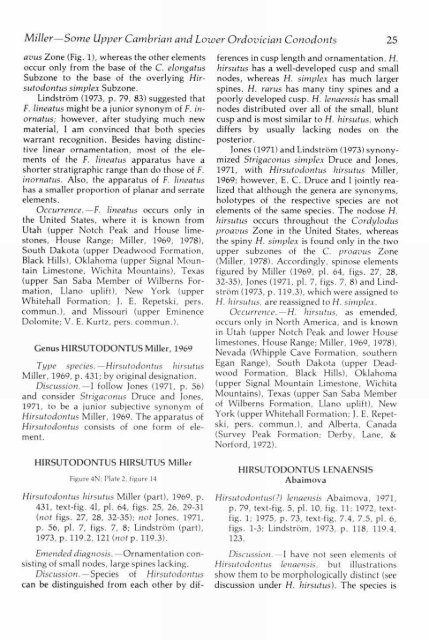View - KU ScholarWorks - University of Kansas
View - KU ScholarWorks - University of Kansas
View - KU ScholarWorks - University of Kansas
Create successful ePaper yourself
Turn your PDF publications into a flip-book with our unique Google optimized e-Paper software.
Miller-Some Upper Cambrian and Lower Ordovician Conodonts 25<br />
avus Zone (Fig. 1), whereas the other elements<br />
occur only from the base <strong>of</strong> the C. elongatus<br />
Subzone to the base <strong>of</strong> the overlying Hirsutodontus<br />
simplex Subzone.<br />
Lindstrom (1973, P. 79, 83) suggested that<br />
F. lineatus might be a junior synonym <strong>of</strong> F. inornatus;<br />
however, after studying much new<br />
material, I am convinced that both species<br />
warrant recognition. Besides having distinctive<br />
linear ornamentation, most <strong>of</strong> the elements<br />
<strong>of</strong> the F. !Meatus apparatus have a<br />
shorter stratigraphic range than do those <strong>of</strong> F.<br />
inornatus. Also, the apparatus <strong>of</strong> F. lineatus<br />
has a smaller proportion <strong>of</strong> planar and serrate<br />
elements.<br />
Occurrence. -F. lineatus occurs only in<br />
the United States, where it is known from<br />
Utah (upper Notch Peak and House limestones,<br />
House Range; Miller, 1969, 1978),<br />
South Dakota (upper Deadwood Formation,<br />
Black Hills), Oklahoma (upper Signal Mountain<br />
Limestone, Wichita Mountains), Texas<br />
(upper San Saba Member <strong>of</strong> Wilberns Formation,<br />
Llano uplift), New York (upper<br />
Whitehall Formation; J. E. Repetski, pers.<br />
commun.), and Missouri (upper Eminence<br />
Dolomite; V. E. Kurtz, pers. commun.).<br />
Genus HIRSUTODONTUS Miller, 1969<br />
Type species. - Hirsutodontus hirsutus<br />
Miller, 1969, p. 431; by original designation.<br />
Discussion. -I follow Jones (1971, p. 56)<br />
and consider Strigaconus Druce and Jones,<br />
1971, to be a junior subjective synonym <strong>of</strong><br />
Hirsutodontus Miller, 1969. The apparatus <strong>of</strong><br />
Hirsutodon tus consists <strong>of</strong> one form <strong>of</strong> element.<br />
HIRSUTODONTUS HIRSUTUS Miller<br />
Figure 4N; Plate 2, figure 14<br />
Hirsutodontus hirsutus Miller (part), 1969, p.<br />
431, text-fig. 41, pl. 64, figs. 25, 26, 29-31<br />
(not figs. 27, 28, 32-35); not Jones, 1971,<br />
p. 56, pl. 7, figs. 7, 8; LindstrOm (part),<br />
1973, p. 119.2, 121 (not p. 119.3).<br />
Emended diagnosis. -Ornamentation consisting<br />
<strong>of</strong> small nodes, large spines lacking.<br />
Discussion. - Species <strong>of</strong> Hirsutodontus<br />
can be distinguished from each other by differences<br />
in cusp length and ornamentation. H.<br />
hirsutus has a well-developed cusp and small<br />
nodes, whereas H. simplex has much larger<br />
spines. H. rarus has many tiny spines and a<br />
poorly developed cusp. H. lenaensis has small<br />
nodes distributed over all <strong>of</strong> the small, blunt<br />
cusp and is most similar to H. lzirsutus, which<br />
differs by usually lacking nodes on the<br />
posterior.<br />
Jones (1971) and LindstrOm (1973) synonymized<br />
Strigaconus simplex Druce and Jones,<br />
1971, with Hirsutodontus hirsuttis Miller,<br />
1969; however, E. C. Druce and I jointly realized<br />
that although the genera are synonyms,<br />
holotypes <strong>of</strong> the respective species are not<br />
elements <strong>of</strong> the same species. The nodose H.<br />
hirsutus occurs throughout the Cordylodus<br />
proavus Zone in the United States, whereas<br />
the spiny H. simplex is found only in the two<br />
upper subzones <strong>of</strong> the C. proavus Zone<br />
(Miller, 1978). Accordingly, spinose elements<br />
figured by Miller (1969, pl. 64, figs. 27, 28,<br />
32-35), Jones (1971, pl. 7, figs. 7, 8) and Lindstrom<br />
(1973, p. 119.3), which were assigned to<br />
H. hirsutus, are reassigned to H. simplex.<br />
Occurrence. -H. hirstitus, as emended,<br />
occurs only in North America, and is known<br />
in Utah (upper Notch Peak and lower House<br />
limestones, House Range; Miller, 1969, 1978),<br />
Nevada (Whipple Cave Formation, southern<br />
Egan Range), South Dakota (upper Deadwood<br />
Formation, Black Hills), Oklahoma<br />
(upper Signal Mountain Limestone, Wichita<br />
Mountains), Texas (upper San Saba Member<br />
<strong>of</strong> Wilberns Formation, Llano uplift), New<br />
York (upper Whitehall Formation; J. E. Repetski,<br />
pers. commun.), and Alberta, Canada<br />
(Survey Peak Formation; Derby, Lane, &<br />
Norford, 1972).<br />
HIRSUTODONTUS LENAENSIS<br />
Abaimova<br />
Hirsutodontus(?) lenaensis Abaimova, 1971,<br />
p. 79, text-fig. 5, pl. 10, fig. 11; 1972, textfig.<br />
1; 1975, p. 73, text-fig. 7.4, 7.5, pl. 6,<br />
figs. 1-3; Lindstrom, 1973, p. 118, 119.4,<br />
123.<br />
Discussion. -I have not seen elements <strong>of</strong><br />
Hirsutodontus lenaensis, but illustrations<br />
show them to be morphologically distinct (see<br />
discussion under H. hirsutus). The species is
















